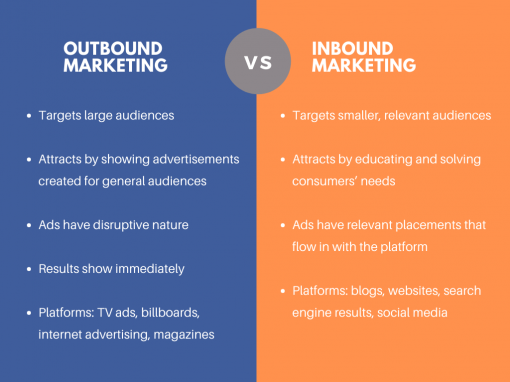
Over the recent years, the number of advertisements people are exposed to has doubled. The marketing platforms are becoming increasingly overpopulated, making it harder for smaller companies to get their spot under the sun. To get proper exposure through TV spots and billboards companies need significant budget numbers. That’s why inbound marketing started picking up the pace over the recent years.
With the boom of startups, instead of choosing to allocate hefty sums from their investments to bombard people with even more adverts, nascent companies started taking a different, more targeted approach to connecting with their prospective audiences. Continue reading, to learn more about the differences between these two marketing methodologies, and understand which way might be the best for your company.
The Main Difference Between Inbound and Outbound Marketing?

| Outbound Marketing | Inbound Marketing |
| 1. Targets large audiences | 1. Targets smaller, relevant audiences |
| 2. Attracts by showing advertisements created for general audiences | 2. Attracts by educating and solving consumers’ needs |
| 3. Ads have disruptive nature | 3. Ads have relevant placements that flow in with the platform |
| 4. Platforms: TV ads, billboards, internet advertising, magazines | 4. Platforms: blogs, websites, search engine results, social media |
| 5. Results show immediately | 5. Results are seen later |
Inbound Marketing: The New Marketing
The main goal of inbound marketing methodology is to first, build a relationship with the prospective buyers on the web, before getting them to convert into customers. This way, the prospects first get to know the company as a thought leader in the niche and come to trust in the brand when making a final decision.
The inbound methodology heavily relies on useful content that is strategically written by first understanding the questions their prospects might ask themselves when looking for a similar product or service. Based on those answers and keywords, the companies craft articles that answer those questions.
The conversion from a website visitor to a lead is then made possible through the call-to-action (CTA) that are carefully placed at the end of the content, whether it’s a blog post or a landing page. The CTAs may have several goals, while some companies may prefer to invite visitors to check out their product lineup, others might prefer to first make a lasting connection by asking them to subscribe to the blog or their social media channels.
The next logical step is ensuring that the written content is discoverable. This is where Search Engine Optimization (SEO) enters the picture. Through this method, companies make sure that their content shows up at the right place at the right time.
How can you serve content to prospects at the right time and the right place? Through search engines. Think of it, nowadays, people Google the answers to their questions. How great would it be if your content showed up first in the results? Wouldn’t it be the perfect place and the perfect time to educate your prospects and let them know how your product can be the supply to their demand?
Showing up first in a Search Engine Result Page (SERP) is no easy task though. To do so, you need to optimize your content by intuitively placing keywords inside, so that the so-called Search Engine Crawlers would understand the relevance of your content to similar search queries.
Ready To Grow Your Pipeline?
Our team of professionals is ready to discuss your project and offer a cost effective way to promote your business to generate quality leads for your sales efforts
Outbound Marketing: The Push Marketing
This methodology is the traditional marketing methodology that has been around for decades. It is most effective for some consumer goods that can be relevant to wide demographics. Good examples are goods like milk, bread, toothpaste, etc.
The main goal of this methodology is to cast a wide net hoping to get as many returns as possible. Ideally, these types of campaigns bring in results immediately. You don’t have to wait for months to see the results like in inbound campaigns. For companies that have to generate income as fast as possible to stay in the game, this is a great appeal.
Outbound campaigns are a great way to raise general awareness about the brand but it is going to be a costly endeavor. Therefore, they are not accessible for most companies, especially new companies that don’t have large budgets. These also refer to startups, who were amongst the first to adopt the inbound methodology for this exact reason.
And then there’s the widespread dislike for the push advertisement format. You see, most of the time, outbound marketing can be disruptive, to say the least. Whether it’s an ad that interrupts a YouTube video, a film on TV or a free ad-supported streaming platform, or pop-up ads during intense reading on the web, the chances are high that you pay to irritate people, rather than get them to connect with your brand.
Which way to go?
This is one of those “it depends” questions. Many companies utilize both. Inbound can take some time to work and if you have the means, combine it with carefully thought out outbound campaigns to get the best of both worlds. Why not?
Hopefully, this article gave you a better idea of both methodologies and their differences. If you have more questions or are in a need of a free consultancy, feel free to reach out to us! PMG360 is home to experts that can help you launch successful Lead Generation, Email Marketing, Display Advertising, and Content Marketing campaigns. Book your Free Consultation now
keep updated on our latest blogs
Subscribe to our Newsletter and never miss an update!
.png?width=383&height=246&name=Dealing%20with%20Digital_%20A%20CEOs%20Handbook%20to%20Navigate%20the%20Inbound-Outbound%20Marketing%20Convergence%20(1).png)

